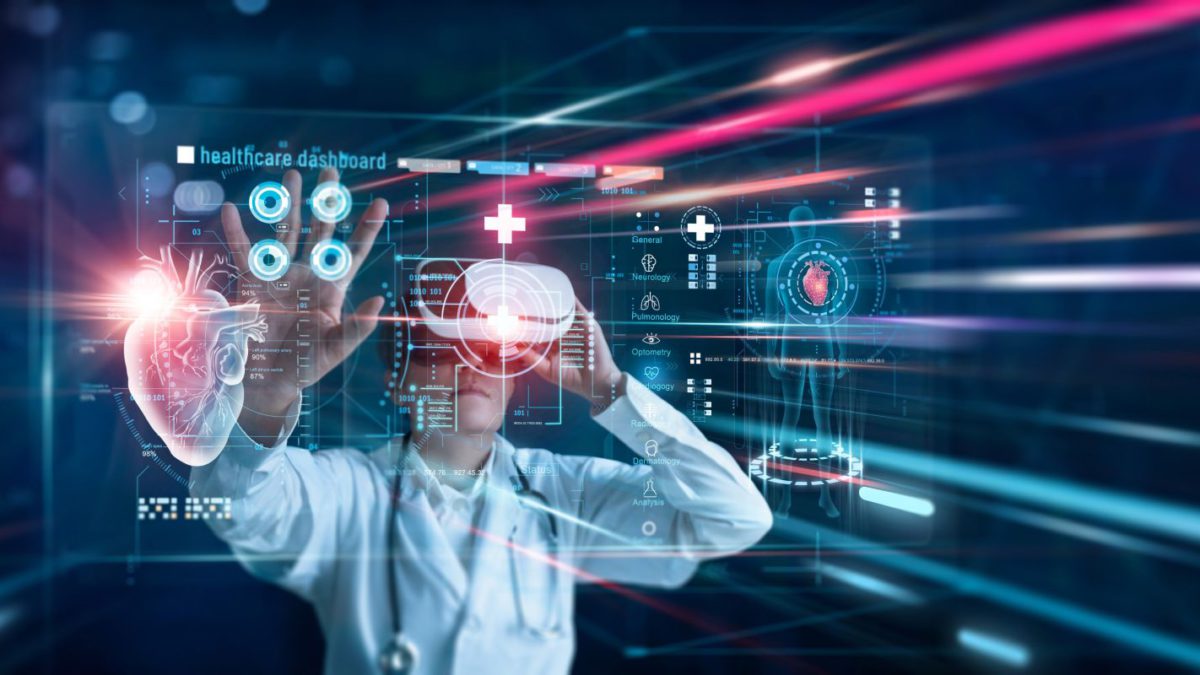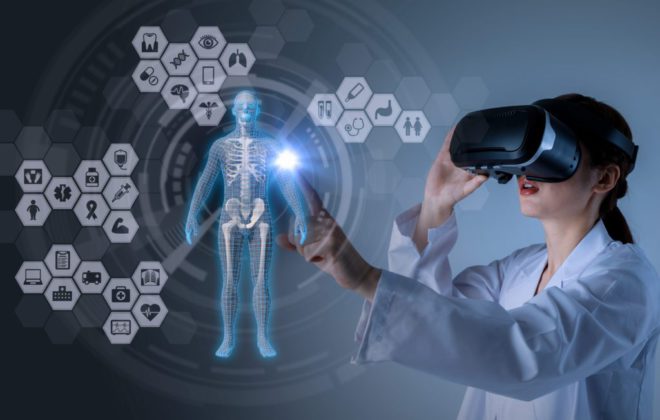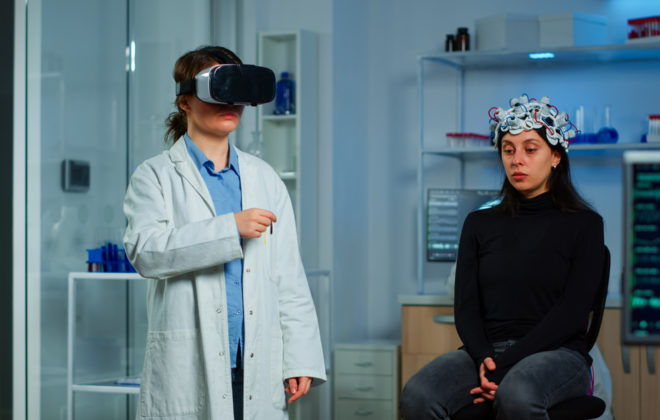AR Applications For Healthcare Professionals
The growing field of medical information and technology is always looking for the best possible care for their patients. With the constant influx of new data and tools, it can be overwhelming to stay updated and make informed decisions. Here comes AR technology as a trailblazer in the hospital sector. This is changing the way healthcare professionals interact with patients and access critical information.
According to a recent report, the virtual and augmented reality business in healthcare will grow to $9.7 million over the next five years. Looking to know more about how AR impacts the hospital industry? Then, continue reading this post!
Overview of Augmented Reality technology
Augmented Reality is a trending technology. It enhances the real world by overlaying virtual objects, audio, and graphics. This technology has been gaining traction in various fields, including healthcare. Here AR technology improves medical training, patient care, and surgical procedures.
Understanding AR Technology
AR technology combines the physical and digital worlds by projecting virtual information onto real-world objects. This is done through head-mounted devices or software on personal devices.
In healthcare, AR offers real-time data visualization, displaying patient data, vital signs, and anatomical structures in the surgeon’s field of view during surgery.
It also provides interactive learning experiences for medical students. Additionally, AR enables personalized medicine by overlaying real-time medical data onto the patient’s body through smart glasses.
AR in Medical Training and Education
Augmented reality technology can be used to create realistic simulations of medical procedures. This allows students and trainees to practice and perfect their skills before performing the procedures on real patients. This greatly enhances the learning experience for medical students. They can experience procedures in a safe and controlled environment.
For example, the Surgical Theater’s Virtual Reality Surgical Simulator uses AR technology. This is to create a realistic 3D model of a patient’s anatomy. This allows trainee surgeons to practice and refine their skills before operating on a real patient.
The simulator includes various instruments and tools, such as forceps and scalpels, enabling trainees to practice procedures in detail. Additionally, the simulator provides feedback on performance. This assists trainees in improving their skills and reducing the risk of complications during actual surgeries.
AR in Patient Care
AR is transforming patient care by enhancing diagnosis and treatment planning through various key applications. One major use is inaccurate symptom detection. AR facilitates the diagnosis of patient symptoms, medical imaging, and health vitals through 3D modeling and visualization.
This improves doctor-patient communication and leads to more accurate diagnosis and treatment planning. Additionally, AR supports patient self-care by guiding individuals through personalized rehabilitation exercises in real-time, promoting faster recovery.
Another critical application is vein visualization. AR helps visualize veins and other anatomical structures, aiding healthcare professionals in performing procedures like blood draws and injections more efficiently and with greater precision. These advancements in AR technology are significantly improving patient outcomes and the overall quality of care.
AR in Surgery and Diagnostics
AR is transforming surgery and diagnostics by providing real-time data and enhanced visualization. In surgical planning and simulations, surgeons can use AR to visualize a patient’s anatomy in 3D before surgery. This allows them to plan their approach with greater accuracy and identify potential challenges.
During surgery, AR overlays can be used. Here, surgeons wear headsets that display real-time patient data, vital signs, and anatomical structures in their field of view. This improves hand-eye coordination and reduces reliance on traditional medical imaging.
In diagnostics, AR aids doctors by visualizing medical data such as blood flow or nerve pathways. This assisting in the diagnosis and treatment of various conditions. These applications of AR are significantly enhancing the precision and effectiveness of surgical procedures and diagnostic processes.
Future Prospects and Challenges
1. Future Prospects of AR in the Hospital Sector
AR technology is doing great in the hospital industry. Here are the future prospects of AR in the hospital sector.
2. Robotic-Assisted Surgery
Augmented Reality combined with robotic-assisted surgery is significantly enhancing the precision and effectiveness of intricate medical procedures.
AR technology guides movements of the surgeons and aids in making well-informed decisions. This can be done by providing real-time overlays of critical information during surgeries. This results in improved surgical outcomes and patient safety.
3. Advanced Wound Care Management
AR technology also helps in managing wounds. It is an innovative solution for wound assessment and treatment.
With the help of AR technology, healthcare professionals can visualize wounds in three dimensions. Also, they can monitor the progress of healing, and devise personalized care plans.
This application accelerates wound recovery and ensures better patient comfort throughout the healing process.
4. Streamline Healthcare Logistics
On the administrative side, AR can improve healthcare logistics, from inventory management to traversing complicated hospital layouts.
AR allows healthcare providers to save time and increase operational efficiency by overlaying information regarding equipment, supplies, and geographical directions right into the physical environment.
This technology streamlines operations. This allows medical staff to swiftly identify needed supplies and navigate the facility more effectively. Also, this improves overall productivity and patient care.
Challenges of Using AR in the Medical Field
Despite its potential, AR technology faces several challenges. Here are the common challenges of using AR in the medical field:
1. Costs
AR technology involves significant expenses for devices like head-mounted displays, apps, and software. Although AR aims to make healthcare more accessible, the high costs can be prohibitive. This financial barrier may limit the extended adoption of AR technology.
2. Potential Technical and Physical Issues
Healthcare clinics are hesitant to adopt AR due to its technological infancy and the limitations of existing hospital computers. Issues such as errors in displaying the depth or position of anatomical structures and low-contrast images can impair the effectiveness of AR applications.
3. Regulations
AR devices and apps must comply with a set of regulations. Following these regulatory requirements in this sector can be feel like time-consuming process. It poses another barrier to the adoption of AR in healthcare.
Final Words
AR applications are transforming the Healthcare Sector. They enhance medical training and healthcare logistics. Despite the challenges of using AR in the hospital sector, the future holds immense potential for AR to improve patient outcomes and healthcare efficiency further.
Blog Categories
- 3D Animation (5)
- Company News (2)
- Design Graphics (1)
- Healthcare Operations (7)
- Industry News (9)
- Medical Training (1)
- Sales Enablement (5)
- Software Developing (3)
- Virtual/Augmented Reality (11)




